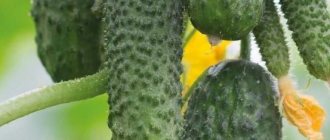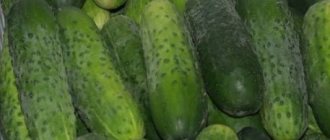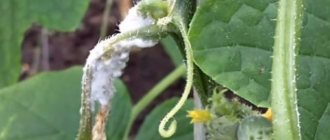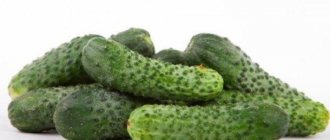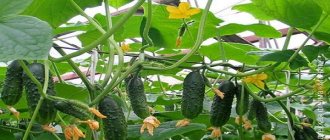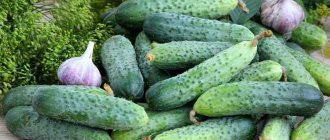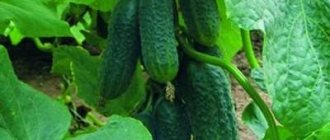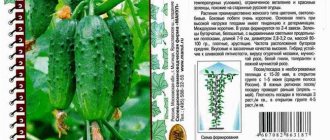Description of cucumbers variety Connie F1
Connie F1 is one of the well-proven early and productive varieties of cucumbers, rightfully considered the best of the heterotic hybrids (all varieties marked F1). The stem of these cucumbers is capable of unlimited growth, and its medium-sized wrinkled leaves have a regular crenate edge. Cucumber Connie F1 can be grown both in greenhouses and in open ground. The fruits ripen 47–50 days after full germination. Juicy and crispy cucumbers of this variety have a cylindrical shape. Their length ranges from 7 to 9 centimeters, weight does not exceed 80 grams. Cucumbers of the Connie F1 variety do not outgrow, even if they were not picked from the garden at the right time. The fruits are covered with frequent small tubercles and have white pubescence.
Connie F1 cucumbers are good for both fresh consumption and homemade preparations
Parthenocarpy (the property of setting fruit on a female ovary without pollination) allows you to obtain a stable harvest of cucumbers regardless of weather conditions. Since cucumbers of this variety produce from 3 to 9 ovaries in each node, the early yield averages 9 kg/sq. m, and marketable - 14 kg/sq. m. The complete absence of bitterness is another quality of Connie cucumbers, thanks to which it has been popular for many years. In 1999, the cucumber hybrid Connie F1 was included in the State Register of the Russian Federation.
Advantages and disadvantages compared to other similar varieties
Among the advantages of Connie cucumbers, it is worth emphasizing the following:
- Cucumbers of the Connie F1 variety are resistant to powdery mildew and root rot, are insensitive to temperature changes and, unlike varieties with similar characteristics, are unpretentious.
- The Connie variety, unlike many varieties that produce a harvest within 3-4 weeks, is characterized by a long fruiting period.
- Cucumber lovers find greens of this variety especially tasty.
- No voids in canned cucumbers.
Certain features of cucumbers of the Connie F1 variety can be conditionally classified as disadvantages:
- Some gardeners, who have previously grown only large-tubercular cucumbers, find the small tubercles and white spines on cucumbers of the Connie F1 variety unusual and consider this their big flaw.
- Since cucumbers of this variety are small in size, there is a misconception about their low yield compared to similar varieties. In order to achieve a high yield, it is necessary to follow the correct agricultural technology, including the appropriate timing and technology of sowing and planting, timely application of fertilizing, watering, etc.
Main characteristics
The formation of the correct cucumber depends on the weather. In most regions, the ripening and growing season is limited to only two months; in northern latitudes it is 35-40 days. Even growing seedlings and hardening them does not always allow obtaining the required volume of harvest. Cold-resistant and shade-tolerant varieties can be either early or late
Therefore, it is important to study in advance the description of each variety and hybrid, reviews about it
Varieties
Note! Varieties and hybrids can be zoned, that is, they differ in additional characteristics. Most often this is the F1 generation, from which it is impossible to obtain seeds.
The main characteristics that need to be studied include:
- ripening period;
- type of pollination;
- form of growth.
The most prolific are the resistant species that grow in long vines. Bush varieties are easier to process, but less productive. Cold-resistant species are often parthenocarpic, that is, self-pollinating. They don't need bees. Insect control is an unstable process, which is also threatened by sudden changes in temperature.
Among the hardy varieties there are all types from super early to late. Mid-season varieties have the highest productivity. They manage to form a sufficient number of ovaries, while hybrids with a long period of active fruiting are in the growing season until autumn, since they are not afraid of lower temperatures.
Advantages and disadvantages
- increased fruiting period;
- low sensitivity to diseases and pests;
- versatility.
The fruits may have a slightly less pronounced taste and aroma. These parameters depend on climatic conditions. Some varieties have thick and rough skin, which is not to everyone's taste. There are no other significant deficiencies. Such cucumbers can be used for fresh consumption and for pickling and preparations.
Note! Among the advantages is a simplified method of cultivating seedlings. There is no need for additional hardening of seedlings before planting in the ground.
Sowing seeds
Sowing seeds of the Connie variety for growing seedlings is carried out in early or mid-April - depending on the region and the intended method of growing them (open or closed ground). Before planting, it is recommended to soak the seeds in warm melt or rain water (you can also use settled tap water), leaving them in a wet linen cloth until the seeds swell and hatch - this usually takes 2-3 days. A better harvest will undoubtedly be facilitated by treating the seeds with a growth stimulant.
It is recommended to soak the seeds before planting
The land for planting cucumbers should be fertilized with organic matter. If your options for using organic fertilizers are limited, consider composting and adding mineral fertilizers to poor soil - cucumbers love them just as much.
Growing seedlings
The hatched seeds are planted in loose, fertile soil to a depth of about one and a half centimeters. For seedlings, it is important to maintain a temperature of at least 24 degrees (at night it should not fall below 16 degrees) and protect it from drafts. Also, additional lighting will not harm cucumber seedlings. If you are growing seedlings at home, it is recommended to plant each seed in a separate pot, cup or bag - this way, when transplanting, the root system will receive a minimum amount of injury.
Some gardeners prefer to grow seedlings of Connie cucumbers not on window sills, but in a small bed directly in the greenhouse. In this case, covering material should be prepared in advance to protect the plants from nighttime drops in temperature.
At the age of 21 days, Connie F1 cucumber seedlings are moved to a permanent place of growth
History of variety selection
The Connie variety appeared in the 90s, thanks to the crossing of cucumber varieties with different dominant traits. The hybrid was developed by Soviet Union scientists in St. Petersburg. After some research, in 1999, the Connie cucumber variety was included in the State Register. Thanks to this, Connie became available for cultivation throughout Russia.
Planting in a greenhouse and in open ground
The place for planting cucumbers should be well lit, but it is advisable that the plants be in light shade for part of the day. Under no circumstances should you grow cucumbers in the same place for several years in a row. You should also avoid planting cucumbers on soils where their close relatives - pumpkins, zucchini, watermelons and other plants of the pumpkin family - were previously grown, since all pumpkins suffer from the same diseases. It’s good if the predecessors of cucumbers are legumes, radishes, cabbage, potatoes or tomatoes.
Both when growing Connie cucumbers by seeds directly into open ground or a greenhouse, bypassing the seedling stage, and when using the seedling method, you should wait until the end of night frosts. By that time the earth warms up to 12–15 degrees. There should be no more than two plants of the Connie variety per square meter of planting. If you plant cucumbers with seeds, you can plant them a little more often, and at the stage of four true petals, discard weak plants.
Before sowing seeds or planting seedlings of Connie F1 cucumbers, you should prepare a special bed for them. To do this, 30–40 cm of the top layer of soil is removed from the bed, the exposed soil is covered with a mixture of pine sawdust, peat and straw, and humus and manure are laid on top of this layer. The final layer of the cucumber bed should be the previously removed top layer - loosened and cleared of weed roots.
Step-by-step description of planting seedlings in open ground
- Water the bed with water from a watering can. Cover the ground with plastic film.
- After 2 days, build planting holes for the seedlings. You can add a little chalk, wood ash, peat or dry manure to them.
- Fill the resulting holes with water.
- Plant the seedlings into the planting holes. Do not water the plants for several days - they need time to adapt to their new location.
How to plant cucumbers in open ground with seeds
- Pour boiling water over the garden bed, then water with added fertilizer.
- Make grooves in the garden bed and place the seeds in them.
- Sprinkle the seeds with a layer of loose soil.
- Cover the bed with film for 4–5 days.
- When the first true leaves appear, spud the stems.
Sequence of actions when planting seeds in a greenhouse
- Soak cucumber seeds in a weak solution of potassium permanganate for 2-3 hours.
- Dry the seeds by spreading them on a paper towel.
- Dust the seeds with Trichodermin.
- Create planting holes in the garden bed, arranging them in a checkerboard pattern.
- Spill the holes.
- Plant the seeds two seeds deep.
Planting cucumber seedlings in a greenhouse
- Make holes in the cucumber bed in a checkerboard pattern corresponding to the size of the pot in which the seedlings grew.
- Water the holes with a solution of organic fertilizer, spending an average of half a liter per hole.
- Place the plants in the holes and fill the pot with soil.
If the seedlings have stretched out a little, the stem should be covered with a mixture of peat and sawdust or the seedlings should be planted a little deeper.
Video: how to plant cucumbers correctly
Disadvantages and advantages of a hybrid
Among the “disadvantages” of this productive hybrid, gardeners note the rather high cost of seeds, as well as the inability to take their own seeds from the fruit. This is impossible to do with hybrid forms, since all the declared characteristics are preserved only in the culture of the first generation of hybrids - F1, and then they disappear. Initially, hybrids contain:
- resistance to adverse conditions;
- disease resistance;
- great taste.
Unfortunately, summer residents cannot obtain hybrid seeds from their harvest; this requires special conditions and, of course, parental lines of the crop.
Some gardeners are distrustful of Connie's fruits, believing that small-tubercular cucumbers are inferior in quality and taste to their counterparts with large tubercles and black thorns. But in fact this is not so, Connie F1 greens are good in all types of pickles and marinades.
Advantages:
- early fruiting periods;
- resistance to a number of diseases, including root rot, powdery mildew;
- resistance to adverse conditions;
- great taste;
- good yield, on average - about 10 kg per square meter, in a greenhouse - up to 13-14 kg;
- bunch type of fruiting;
- suitability for conservation;
- not bad keeping quality.
In order to obtain the yield declared by the manufacturer, it is necessary to take care of adequate nutrition of the hybrid, as well as follow basic agricultural practices.
Caring for Connie F1 cucumbers
In the open ground
- Protection from wind and provision of branching. From the wind, it is recommended to install trellises along which the stems can curl.
- It is better to water Connie cucumbers early in the morning or at sunset, preferably daily, waiting for the soil to partially dry out. Regular watering is especially important during the fruit formation stage.
- You should also weed the cucumber beds at least once a week.
Pollination or the use of special means to attract insects is not required for cucumbers of the Connie variety.
In the greenhouse
- Temperature control and ventilation. It is important to avoid excessive temperature increases and excessive lighting. To lower the temperature, the greenhouse is regularly ventilated by opening doors and vents. If ventilation does not have the desired effect and the temperature exceeds thirty degrees, you can spray the walls of the greenhouse with a weak aqueous solution of chalk - such shading will create diffused light. If the duration of daylight hours decreases, the greenhouse can be washed of chalk, although rain can also do a good job of this task.
- The air humidity in the greenhouse when growing Connie cucumbers should be at least 90%. It can be maintained by spraying and watering.
- Water Connie's cucumbers with settled warm water 2-3 times a week on hot days, and in cloudy weather - no more than twice a week. Overmoistening the soil can lead to diseases of the root system! The rate of watering of cucumbers of the Connie variety is quite simple to determine: the number of liters required for optimal watering of plants depends on the depth of penetration of their roots. Cucumber seedlings usually penetrate no more than 3 cm deep, so they need to be watered at the rate of 3 liters per 1 m2; During the fruiting period, the roots penetrate 15–17 cm, so the cost of watering 1 m2 of soil on which cucumbers grow should be 15–17 liters.
- Loosening. In order for water to reach the roots of plants, it is necessary to loosen the soil in which they grow. The first loosening is carried out 3 weeks after planting the seedlings in the greenhouse. You need to loosen the soil very carefully so as not to damage the roots of the plants. Next, you need to loosen the cucumbers when the first signs of compacted soil appear. If the plants have grown, intertwined and loosening has become difficult, 4–6 punctures with a fork can be made per 1 m2 to the depth of the horns. This type of loosening for Connie cucumbers is extremely useful and allows you to increase their productivity.
Another advantage of growing Connie cucumbers in a greenhouse is the ability to increase the intensity of their development and increase productivity by increasing the carbon dioxide content in the air. To do this, start the fermentation process by placing a mixture of manure and water in a barrel located in the greenhouse.
Video: subtleties of caring for cucumbers in a greenhouse
Feeding and fertilizer (table)
It is difficult to obtain a good harvest without fertilizing cucumbers with organic fertilizers, so fertilization should be done frequently, but in small quantities.
| Plant development stage | Feeding frequency | Amount/concentration | Drug (components) | Effect of the drug | How to deposit |
| Before flowering | 1 time | 1 tbsp. l. for 10 liters of water | Complex fertilizer Agricola-5 | Increases the energy of plant cells, enhances the digestibility of nutrients, and the resistance of plants to adverse factors. | Copious spraying |
| Flowering period | 1 time | 1 tsp. each component per 10 liters of water | Superphosphate, urea, potassium sulfate + 1 tbsp. organic fertilizer humate Fertility | Promotes the plant's fullest use of nutrients from the soil, the accumulation of chlorophyll, vitamins, sugars, and prevents the excessive accumulation of nitrates. | Watering |
| Fruiting period | 4 times every 10 days | 1 tbsp. l. liquid fertilizer, 1 tsp. Nitrophoska per 10 liters of water | Potassium humate or Agricola-vegeta, Ideal, Nitrophoska | Enhances the absorption of nutrients by the plant, the growth of the root system and the vital activity of the entire plant. | Watering at the rate of 5 liters per 1 m² |
| 0.5 liters of manure, 1 tsp. potassium sulfate per 10 liters of water | Cow or any other dung, potassium sulfate | Increases the intensity of photosynthesis and the rate of fruit development, increases resistance to diseases. | Watering at the rate of 5.5–6 liters per 1 m² | ||
| 1 tbsp. l. Nitrophoska, 2 tbsp. l. organic fertilizer per 10 liters of water | Nitrophoska, universal organic fertilizer (for example, Barrier) | Promotes the growth of healthy vegetative mass, improves the taste of fruits. | Watering at the rate of 6–9 liters per 1 m² | ||
| 1 tbsp. l. organic and complex fertilizer per 10 liters of water | Fertility, Agricola-5 | Promotes holistic strengthening of plants, increasing the duration of fruiting. | Watering at the rate of 5 liters per 1 m² |
Any feeding of Connie cucumbers should be done in the morning or evening, preferably in cloudy weather.
Care
Connie f1 cucumber bears fruit abundantly and produces maximum yields if the following agrotechnical measures are observed:
- After planting, seedlings should be protected from sunlight, which can cause the plants to wilt or burn the leaves.
- Cucumber crops are first covered with a protective material to protect them from even short-term temperature fluctuations.
- Watering is carried out with warm water after the heat decreases.
- Must protect plants from waterlogging of the soil, which often causes diseases of the root system.
- Beds with cucumbers require regular weeding, followed by loosening the top layer of soil and mulching.
- Before mass flowering, root feeding is carried out once every two weeks using easily soluble mineral, organic or complex fertilizers, among which the best high-quality complex fertilizers “Yara Mila Complex” show the best results.
- From the very beginning of flowering until fruiting ends, fertilizing is carried out 2 times a week with Plantafol and Green Go or Terrafleks.
Expert opinion Filatov Ivan Yurievich, private farmer for more than 30 years
Any species and hybrids of cucumber do not tolerate high concentrations of fertilizers very well, so it is recommended to feed them more often, but using a lower dosage.
Signs of damage to cucumbers by pests and diseases
The main pests of cucumbers include the cucumber bug, spider mites, aphids and greenhouse whiteflies.
The cucumber bug is a black insect 2–3 mm long. It lives on the underside of cucumber leaves and prefers greenhouses to open ground. You can determine whether plants are affected by the cucumber bug by directly seeing it on the leaves or by looking at the curled leaves - the bug sucks all the juice out of them.
Spider mites indicate their presence on plants by the appearance of individual white dots on the leaves, followed by whitening of the entire leaf. In the absence of measures to combat the mite, within one to two weeks the plant is covered with a continuous web, and parasites accumulate in large numbers on its tops.
Aphids not only eat young shoots and leaves of plants, but also during their life processes secrete a sticky substance, which is a favorable environment for the proliferation of fungal infections. A sign that aphids have settled on the plant is the appearance of wrinkled and curled leaves. Aphids can only move onto cucumbers from weeds, so don’t neglect weeding!
The greenhouse whitefly also sucks the juice from cucumber leaves. During the course of the disease, caused by the proliferation of whiteflies on cucumber leaves, they become covered with a white sugar coating. Then the leaves turn black and dry out.
Anthracnose is one of the most terrible diseases of cucumbers, literally and figuratively. Symptoms of the disease are brown spots on the stems and leaves of plants, deep weeping ulcers on cucumbers. Since anthracnose is fungal in nature, it progresses significantly in high humidity, heavy dew and rainy weather.
Sclerotinia or white rot is another fungal disease of cucumbers, which is predominantly distributed in greenhouses. Sclerotinia spores live in the soil, so getting rid of it is not so easy. The root part of the stem is the first to be affected. Sclerotinia is easily identified by watery, wet spots that eventually become covered with a white, cotton-like substance. Sclerotinia causes rotting of the fruit and death of the entire plant.
Photo gallery: how to recognize pests?
Leaves of a cucumber infected with greenhouse whitefly
Aphids on cucumbers are visible to the naked eye
Whitening of a cucumber leaf is a sign of spider mite damage to the plant.
Cotton-like clumps on cucumber stems with sclerotinia
Cucumber leaves affected by anthracnose
Description
The cucumber hybrid “Connie F1” is parthenocarpic, that is, it does not require the participation of pollinating insects to form ovaries and fill fruits. (Many people mistakenly call such hybrid forms “self-pollinating.”)
All original varieties of cucumbers are dioecious, that is, they have flowers of different sexes and require pollination by insects that transfer pollen from male flowers (barren flowers) to female ones
Unlike bee-pollinated varieties and hybrids of cucumbers, parthenocarpic ovaries grow into greens without fertilization, which significantly reduces the dependence of their yield on weather conditions and the presence of insects. The seeds in unfertilized greens do not have embryos and therefore do not ripen. This property has a positive effect:
- on taste: the seeds are small and tender, without a rough shell;
- on marketability of appearance: the fruits have almost the same size and color, do not overgrow, do not become deformed, and do not turn yellow.
Even if parthenocarpics are pollinated and full-fledged seeds ripen in them, it makes no sense to use such seed material for planting the next season. All heterotic hybrids labeled “F1” combine improved parental qualities and exhibit them only in the first generation.
Note that the development of hybrids with stable parthenocarpic properties is an achievement of selection, not GMO.
Many plants exhibit a natural tendency towards parthenocarpic development of fruits (in addition to cucumbers, these are tomatoes, apples, pears, grapes, tangerines, etc.). And in parthenocarpic hybrids, this property was consolidated at the level of a genetic trait.
Many note the high early yield of the cucumber hybrid “Connie F1”
Of course, vegetable crops that do not require pollination are intended primarily for growing in protected soil conditions - under film covers, in all types of greenhouses, where insect access is limited. In such situations, parthenocarpics are more convenient and profitable, as they provide stable high yields.
Although the hybrid “Connie F1” is declared as early ripening, in terms of ripening time it would be more correct to call it medium, since fruiting begins on the 47-50th day from the moment of the appearance of full shoots.
Indeterminate cucumbers in greenhouse conditions are grown vertically, tying and wrapping vines around a stretched trellis or net, forming bushes according to various patterns
The plant is indeterminate, that is, unlimited in growth, powerful and vigorous with medium climbing and foliage. The leaves are small, wrinkled, with regular crenate edges.
The type of flowering is female, which ensures a large number of ovaries, which are often laid in bunches (from 3 to 9 pieces per node), and the absence of barren flowers.
The greens of the hybrid “Connie F1” are distinguished by their small (gherkin) size and small tubercles often located on the surface
Zelentsy are very short, gherkin-type - 7-9 cm, proportional, cylindrical-oval in shape, round in cross section. The average weight of greens is 60-82 g, the taste is excellent, without bitterness. The surface is covered with small and frequent tubercles, the pubescence is white, non-spiny. The skin is thin, rich green in color, the flesh is dense, juicy, and does not form voids during heat treatment. Greens are used fresh (as salad greens), and also salted and pickled.
Packages with seeds of the hybrid variety of cucumbers “Connie F1” from various manufacturers
The hybrid is valued for its resistance to powdery mildew and root rot, endurance in unfavorable conditions, for example, with temperature changes, and unpretentiousness.
In agricultural cultivation technology, this hybrid is not particularly difficult: it is important to choose the right time for sowing seeds or planting seedlings, watering and fertilizing plants in a timely manner, weeding and loosening the soil. To obtain maximum yield and longevity of the harvest, it is recommended to shape the bushes
How to form parthenocarpic hybrid cucumber plants in a greenhouse, see the video at the end of the article.
Protection from diseases and pests (table)
The drugs presented in the table can be used to carry out both preventive and protective measures against the main pests and diseases of cucumbers.
| Pest/disease | A drug | Periodicity | Mode of application |
| Pests | |||
| Cucumber bug | Infusion of tobacco or chamomile | 2 times a month | Spraying |
| Spider mite | Decoction of tomato tops, Persian chamomile infusion, dandelion infusion, wormwood infusion | 2 times a month | Spraying the bottom of the leaf |
| Aphid | Red pepper infusion | If weed removal is insufficient - 1 time, repeat after a week | Spraying plants and paths in a greenhouse |
| Greenhouse whitefly | Actofit (0.2%) | 2–3 times during the growing season | Spraying |
| Diseases | |||
| Anthracnose (scarden) | 1% solution of Bordeaux mixture or 0.4% copper oxychloride, preparations Kuproxat and Oxychom | 1 time every 2 weeks | Spraying |
| Sclerotinia | Potassium permanganate | One-time when planting seedlings | Watering the holes |
| Bacteriosis of cucumbers | 0.02% solution of zinc sulfate | One time before boarding | Soaking the seeds |
Prevention of all fungal diseases in the greenhouse is its timely ventilation and compliance with the optimal humidity regime.
When can we expect the harvest?
When growing cucumbers of the Connie variety in a greenhouse, the time of harvesting the first harvest coincides with the time of planting cucumber seedlings in open ground. So, if you plant Connie F1 cucumbers on April 15, you will harvest their first harvest in early June. Most of the harvest of cucumbers of this variety is harvested early and consumed mainly fresh, although the extended fruiting period and high taste make it possible to successfully use them in making preparations for the winter. Therefore, feel free to plant Connie cucumbers if you like experiments: having received a good harvest and putting in a little effort in canning, in winter you can enjoy crispy pickled cucumbers, cucumber rolls in apple cider vinegar, pickled gherkins in cucumber sauce, and even jam made from greens.
Weaknesses and strengths of the variety
The variety has a high yield and ripens early. Fruits usually appear 60 days after planting. Productivity – 9 kilograms per cucumber bush. The second harvest is slightly larger, about 14 kg per square meter. To maintain good fruiting, you need to observe sowing dates and proper care. Yields are significantly higher under greenhouse growing conditions.
Before purchasing seeds, you need to know all the advantages and disadvantages. Among the advantages are:
- excellent yield indicators and mid-early ripeness;
- good immunity to diseases and resistance to changing climatic conditions;
- the fruits appear and ripen together;
- excellent taste of fruits;
- female type of flowering;
- there is no emptiness in the cucumbers;
- no barren flowers;
- do not require pollination by insects.
Gardeners highlight among the disadvantages that the fruits grow small. At the same time, they have white fluff and bumps.
Advice! Due to the large size of the cucumber bush, it needs to be tied up and watered thoroughly.
Storage conditions and periods
Connie F1 cucumbers can be stored fresh at room temperature or in the refrigerator in the vegetable compartment without special preparation for no more than 3–5 days. For longer storage, when harvesting cucumbers, it is important not to tear off their stalk or wash off the natural coating on them. If these conditions are met, you can dip the cucumber stems in water and, placing them together with the vessel in this form in the refrigerator, store the greens for 3-4 weeks. If you need to store Connie F1 cucumbers for 10 days, wrap each of them in a paper napkin and place them in a plastic bag . Cucumbers prepared in this way should be stored in the refrigerator.
It is important to know that cucumbers cannot be stored at low temperatures - even at a slight minus, they become covered with sticky mucus and quickly soften.
Properly frozen cucumbers of the Connie F1 variety, after defrosting, retain their excellent taste and aroma, are suitable for preparing not only okroshka, but can also be used as a side dish, decorating sandwiches and for cosmetic purposes.
Video: how to freeze cucumbers correctly
Advantages and disadvantages
Among the advantages of this hybrid are:
- resistance to various diseases (root rot, powdery mildew, etc.);
- low sensitivity to temperature changes;
- long fruiting period;
- tasty juicy pulp;
- preservation of fruit density in preservation.
As for the disadvantages of the “Connie F1” cucumber, they can be considered relative, since they do not indicate the negative characteristics of the variety, but rather its distinctive features. Some, for example, consider the very shape and structure of the fruit, covered with small tubercles and white spines, to be a disadvantage. Others talk about insufficient yields due to the small size of the cucumbers. However, such comments more often indicate not the weaknesses of the cucumber variety, but the personal preferences of gardeners and habits and stereotypes formed over many years.
